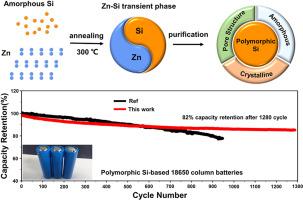长寿命锂离子电池阳极用Zn-Si瞬态相低温结晶
IF 14.2
1区 材料科学
Q1 ENGINEERING, MULTIDISCIPLINARY
引用次数: 0
摘要
硅是一种很有前途的高能量密度锂离子存储负极材料;然而,其在锂化过程中严重的体积膨胀和有限的循环稳定性仍然是实际应用的重大挑战。在这项研究中,我们提出了一种创新的方法来解决这些问题,通过设计一种多晶纳米结构,包括非晶、纳米晶和纳米孔域,通过在低温下分解Zn-Si瞬态相合成。在商用18650型全圆柱形电池中进一步评估了多晶硅的锂离子存储性能,该电池表现出出色的可循环性——在1C倍率下循环1280次后仍保持82%的初始容量——以及出色的倍率能力(在8C倍率下保持82.8%的容量)。此外,初始锂化诱导的多晶硅阳极的体积膨胀率被显著抑制在23.5%,而在基准商用阳极中观察到的体积膨胀率为32.9%。这项工作表明,由Zn-Si瞬态相介导的低温结晶是工程先进硅纳米结构的有效策略,强调了多晶硅阳极在高性能储能应用中的巨大潜力。本文章由计算机程序翻译,如有差异,请以英文原文为准。

Low-temperature crystallization via Zn–Si transient phases for long-life Li-ion battery anodes
Silicon is a promising anode material for high-energy-density lithium-ion storage; however, its severe volumetric expansion during lithiation and limited cycling stability remain significant challenges for practical applications. In this study, we present an innovative approach to addressing these issues by designing a polymorphic nanostructure comprising amorphous, nanocrystalline, and nanoporous domains, synthesized via the decomposition of Zn–Si transient phases at low temperatures. The lithium-ion storage performance of the polymorphic silicon was further assessed in commercial 18650-type full cylindrical cells, which demonstrated outstanding cyclability—retaining 82 % of the initial capacity after 1280 cycles at a 1C rate—as well as excellent rate capability (maintaining 82.8 % capacity at 8C). Moreover, the initial lithiation-induced volume expansion of the polymorphic silicon anode was significantly suppressed to 23.5 %, compared to 32.9 % observed in a benchmark commercial counterpart. This work demonstrates that low-temperature crystallization mediated by Zn–Si transient phases is an effective strategy for engineering advanced silicon nanostructures, underscoring the significant potential of polymorphic silicon anodes for high-performance energy storage applications.
求助全文
通过发布文献求助,成功后即可免费获取论文全文。
去求助
来源期刊

Composites Part B: Engineering
工程技术-材料科学:复合
CiteScore
24.40
自引率
11.50%
发文量
784
审稿时长
21 days
期刊介绍:
Composites Part B: Engineering is a journal that publishes impactful research of high quality on composite materials. This research is supported by fundamental mechanics and materials science and engineering approaches. The targeted research can cover a wide range of length scales, ranging from nano to micro and meso, and even to the full product and structure level. The journal specifically focuses on engineering applications that involve high performance composites. These applications can range from low volume and high cost to high volume and low cost composite development.
The main goal of the journal is to provide a platform for the prompt publication of original and high quality research. The emphasis is on design, development, modeling, validation, and manufacturing of engineering details and concepts. The journal welcomes both basic research papers and proposals for review articles. Authors are encouraged to address challenges across various application areas. These areas include, but are not limited to, aerospace, automotive, and other surface transportation. The journal also covers energy-related applications, with a focus on renewable energy. Other application areas include infrastructure, off-shore and maritime projects, health care technology, and recreational products.
 求助内容:
求助内容: 应助结果提醒方式:
应助结果提醒方式:


